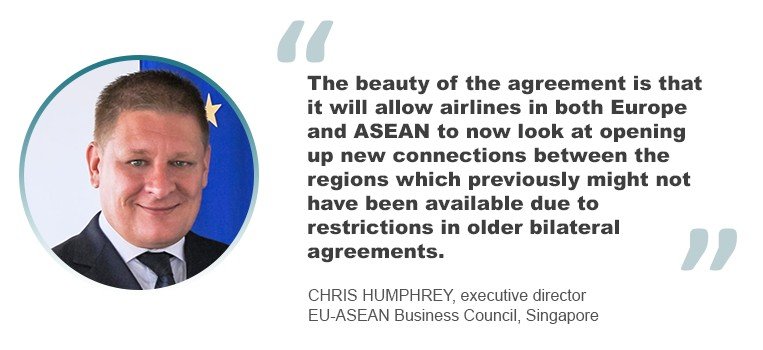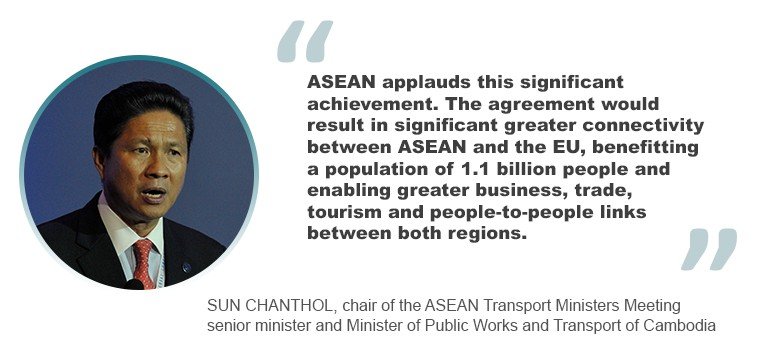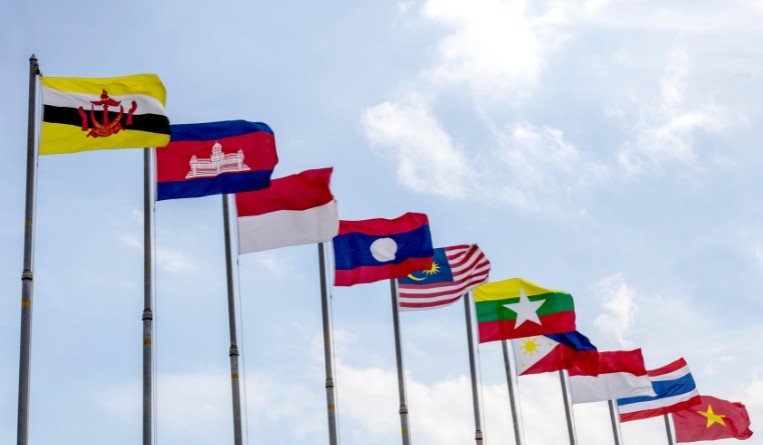Member states of the Association of Southeast Asian Nations (ASEAN) and the European Union (EU) have concluded the negotiations on the ASEAN-EU Comprehensive Air Transport Agreement (AE CATA) – the first bloc-to-bloc air transport deal in the world.
The AE CATA will bolster connectivity and economic development among the 37 member states of ASEAN and the EU. It was approved at the virtual ASEAN-EU Senior Transport Officials Meeting on June 2, 2020.
In a statement, ASEAN – whose 10 member countries include Brunei, Cambodia, Indonesia, Laos, Malaysia, Myanmar, the Philippines, Singapore, Thailand and Vietnam – noted that under the agreement, airlines of ASEAN and the EU will have greater opportunities to operate passenger and cargo services between and beyond both regions.
Airlines of ASEAN and the EU will also be able to fly any number of services between both regions. In addition, carriers will be able to operate up to 14 weekly passenger services, and any number of cargo services via and beyond to any third country.
Opening up new routes between ASEAN, EU
Chris Humphrey, executive director of EU-ASEAN Business Council in Singapore, told Asia Cargo News that the specifics on the new routes “will take time to see” – depending on how travel opens up amid the ongoing pandemic. Nonetheless, he noted that there is positive sentiment that the deal will lead to “an expansion in air services, both for cargo and passengers” for both regions.
“The beauty of the agreement is that it will allow airlines in both Europe and ASEAN to now look at opening up new connections between the regions which previously might not have been available due to restrictions in older bilateral agreements,” Humphrey said.

“Increased connectivity and increased availability of new flight routes and volumes has historically always led to more trade and more people-to-people connections. Prior to Covid-19, trade between the EU and ASEAN was growing, and there is no reason not to suspect that that long-term trend will not return.”
He said that the new air transport deal should also enable the easier transport of goods between the two regions.
Jock Hoi Lim, secretary-general of ASEAN, said separately that with US$10.5 billion of foreign direct investment inflows and US$226.2 billion of trade in goods in 2020, the EU is already the third largest source of investment and the third largest trading partner for ASEAN.
“The AE CATA would significantly strengthen air connectivity between ASEAN and Europe and bring both regions even closer together. This would allow them to reap further economic benefits,” he said in a statement.
ASEAN’s 10 member states form an economic powerhouse, with the bloc now the fifth-largest economy in the world if it were a single country, with total GDP amounting to approximately US$3.11 trillion as of 2020.
China is currently the biggest trading partner of the ASEAN region, followed by the United States, the EU and Japan.
Perishables trade seen to grow
Meanwhile, Humphrey told Asia Cargo News when sought for details that “more cargo routes and flights will naturally boost the capacity for transporting perishable goods between the two blocs” which he said in turn, will “allow new markets on both sides to open up.”
“It removes limits on destinations and flight numbers, and also allows from more fifth freedom flights. From a commercial point of view, the airline community on both sides will welcome that as it provides more certainty for them,” he said, noting, however, that the agreement also encompasses a broad range of other areas such cooperation on air traffic management, security, safety, etc.,“which will significantly help ASEAN in the development of their own aviation sector.”
Adina Vălean, the European Commissioner for Transport, echoed this saying that the new agreement provides the parties a “solid platform” to continue promoting high standards on various issues facing the industry – including environment and social matters.
“The conclusion of this first-ever ‘bloc-to-bloc’ air transport agreement marks an important milestone in the EU’s external aviation policy. It provides essential guarantees of fair competition for our European airlines and industry, while strengthening reciprocal prospects for trade and investment in some of the world’s most dynamic markets,” Vălean said.
Sun Chanthol, chair of the ASEAN Transport Ministers Meeting and senior minister and Minister of Public Works and Transport of Cambodia, lauded the agreement and noted the benefits that are expected to come out from the historic deal.
“ASEAN applauds this significant achievement. The agreement would result in significant greater connectivity between ASEAN and the EU, benefitting a population of 1.1 billion people and enabling greater business, trade, tourism and people-to-people links between both regions,” he said in a statement.

The AE CATA is seen to provide a foundation for closer cooperation between ASEAN and the EU in areas such as aviation safety, air traffic management, consumer protection, and environmental and social matters.
Enforcement expected by year end
The ASEAN and the EU will now submit the AE CATA for legal scrubbing in preparation for signature at a later date to be confirmed.
“The agreement needs to be signed by both sides. We understand that this is likely to happen at the ASEAN Senior Transport Officials Meeting later this year. After that the Agreement should come into force,” Humphrey said.
The ASEAN-EU air transport agreement builds upon the region’s existing initiatives such as the Enhanced ASEAN Regional Integration Support from the EU; the EU-South East Asia on Cooperation on Mitigating Climate Change impact from Civil Aviation: Carbon Offsetting and Reduction Scheme for International Aviation, which supports CORSIA implementation; and the EU-South East Asia Aviation Partnership Project.



